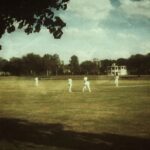Roger Federer and Rafael Nadal: Different Yet The Same
The tennis of Federer and Nadal looks, tastes, and sounds very different.
From the style of their game, to their on-court personas, the physical tools of their success could not be more different.
Rafa exudes passion, energy, intensity, utter commitment in every pump and jump and gesture. Roger exudes a stillness, a calmness, an easy control of emotions: serious and contained almost to the point of self absorption.
One is an explosion of fearsome emotion, the other a still millpond, deep but deadly.
Where Rafa explodes with color and emotion like a Van Gogh painting, Roger is a complex interweaving of subtle tints like a Cezanne.
Yet the canvases of their games are both the result of the same palette of colors, the same brushes, the same obsession.
Start with the raw material: family, roots, upbringing.
They are summer sons: one June, one August. They each have one sister. They both grew up, and are still part of, a close and supportive family unit.
In their early years, either could as easily have chosen soccer as tennis. Neither did, and ever since they have committed themselves unswervingly to their sport.
They trained in their home countries. The German-speaking Federer moved to the French-speaking part of Switzerland but was bitterly home-sick. Nadal stayed at home to be coached by his Uncle Toni.
Their reliance on trusted friends and family has continued unbroken ever since. Federer runs his career like a well-oiled machine, helped by his constant small entourage. There’s conditioning maestro, Pierre Paganini, Swiss tennis coach, Severin Lüthi, and—most important of all—there’s Mirka, the emotional bedrock on which the Federer career is built.
Nadal’s constant is the ever-present Toni Nadal, one of the longest and most successful coaching partnerships in tennis. But Toni is also mentor, friend, and emotional anchor—very much an echo of Mirka Federer.
Toni’s influence goes beyond day-to-day coaching and support, though. He has instilled in his charge the values that Rafa still epitomises: hard work, modesty, sportsmanship, discipline, and perspective.
Toni used to get his nephew to train on poor courts with bad tennis balls, just to teach him that winning or losing wasn’t about equipment or surroundings, but attitude and hard work. He continues to make Rafa do his own laundry, maintain his own rackets, and insists on self-reliance and self-discipline off court.
Federer’s values too derive from his parents. In a revealing interview just this week for the UK’s Daily Mail, he said:
“They would always ask me to ensure that I didn’t waste their money when I was using practice courts or getting coaching as a kid. They always said that they didn’t mind driving me around Switzerland every week to play in a tournament…were fine whether I won or lost, as long as I tried hard and didn’t waste their weekends. The work ethic I have today stems from that simple thing.”
At courtside, whether it’s first round or final, that support is still there, a quiet presence rather than vociferous involvement.
Move into the early years of the Roger and Rafa success story.
For Federer, this means journeying back seven years to his first Slam title at Wimbledon 2003. So accustomed are we now to the suave, sophisticated Federer of made-to-measure polos, embroidered—understated of course—RF logo, and pristine accoutrements that it’s easy to forget the pimpled forehead, scraggy ponytail, and beads.
Hard, too, to imagine him ambling, unshaven, onto Centre Court in an ugly polo around three times too big, shaped like a sack on the adolescent frame of a young man about to win his first Slam. Yet that was where he began.
The ponytail lasted for four Slams, the sloppy T-shirts until the eighth Slam.
Nadal burst into the tennis consciousness with the impact lime and salt around a Margarita glass. The look was young, zesty, sexy. Cropped sleeves showed off the musculature of a twenty-something man, but the pirate pants gave the game away. He was just shy of his 19th birthday when he won the French Open in 2005.
The hair was long and straggly and loose, the personality as big as his biceps. Yet, in an echo of the Federer transition, the switch to a more traditional garb took just five Slams, the hair has shortened by the season, and the Rafa logos are all in place.
Both men have broken the mold in their own way, both have been trendsetters, unafraid to take chances with their image.
Who can forget the impression of “Darth” Federer at Flushing Meadow in 2007? Or the wildly over-the-top gold hold-all at Wimbledon 2009?
By the same token, Rafa will forever be remembered for setting the sleeveless T-shirt trend, though he dropped it so soon. Now he’s willing to try out shocking pink, acid yellow, or brown trellis patterns.
Parallel paths.
Federer and Nadal played the first of their 20 matches exactly six years ago, in the second round of Miami. Soon after their second meeting, also in Miami, they became the top two ranked players for an unbroken four and a half years (give or take a fortnight last summer).
Little wonder, then, that they should constantly meet at the very end of tournaments: 16 of their encounters have been in finals, the rest in semis.
By Nadal’s current age, 23, Federer had won the same number of major titles: four Slams and two WTFs to Rafa’s six Slams.
They both hold Open era records for consecutive wins on a single surface: Federer on both grass and hard courts, Nadal on clay.
All three records were ended by the other man.
One of the most interesting parallels of all is how they approach their tennis.
It is as though, in order to take control of their own games, they slip into a secondary persona as they step onto court. The extrovert, confident, sociable Federer, who as a teenager saw matches lost along with his temper, draws on a cloak of self-control, of inward focus, undemonstrative, enforced relaxation.
The naturally reticent Nadal casts off the bashful smile and assumes a bravado and an aggression quite at odds with the Nadal who walks with Uncle Toni to Wimbledon, laden with his own bags.
And with those assumed characters, the parallels disappear in a vapour of contrasts. Chalk and cheese, fire and ice, power and grace. It’s all been said.
That contrast in persona and in style suggests to some a difference in desire, a difference in motivation. The fist pumping, muscle-flaunting celebrations of Nadal can make Federer’s occasional fist flexing or growled “allez” look the wrong side of passionate.
In fact, they are two sides of the same coin. You say tomato, I say tomayto…
Federer may talk now of records, and is in touching distance of several more. But that is not what made him leave home at 14 to pursue his love of tennis.
It’s not what made him rein in his emotions and his temper when the wins failed to come.
It’s not what made him continue to play through glandular fever, injury, and naysayers ready to draw a line under his achievements.
And it’s not what drove him out to the local Geneva courts at the crack of dawn two weeks after becoming a father.
He hits a bad patch and his response—after losing to Tomas Berdych in Miami—is, “This only fuels my desire to go to the practice courts and figure out what’s wrong, and get better.”
That willingness to train as hard as anyone, to try out new game plans, work out new strategies, adopt a forehand drop shot, and work at the serve-volley is hardly evidence of a diminishing of desire to play and to win.
Nadal has the same desire, the same drive. He is Gene Kelly to Federer’s Fred Astaire: the hard work is there to see in the energy, the muscle, and the sweat. But listen to Ginger Rogers describe the training regime of her famous partner and decide whether Astaire was any less driven than the more overtly athletic Kelly.
Rafa is like an energetic young brother emulating a high-achieving older sibling, infused with the same work ethic, the same desire, but with different tools.
He, too, is already adapting, learning new ways, new strategies, perhaps looking ahead five years to where he needs to be by 28. The serve is bigger, wider, more accurate. There are net approaches, and sliced backhands, drop shots and lobs.
After his defeat in Miami, he pronounced this near echo: “I just have to keep working like this, keep improving.”
Parallel paths.
Federer is further down his path, of course, and Nadal’s story has not yet fully unfolded. Perhaps by 28, he will also be ticking off the records, and shifting and adjusting to new personal circumstances.
But in watching the evolution of Nadal, it’s easy to see its parallels with the progression of Federer’s career.
There are those superficial things, of course: the tweaking of image and the light-hearted, extra-curricular asides—fashion shows and pop videos, adverts for chocolate and for sunshine islands.
Nadal, though, has sat alongside chairman Federer on the Players’ Council. He’s worked at his English in order to become more confident in interviews. He comes to watch the older man play his matches.
They have set new standards in tennis PR, in media responsibilities, and in breaking down the barriers between the cash-paying fans and the players.
Ambassadors par excellence.
Bottom line, they are both serial winners who have together taken the game to new levels. They have even introduced new shots to the game: Rafa’s lasso forehand, Roger’s reverse cross-court slice, lifted verbatim from the squash court.
So the rivalry is not so much a stick with which to beat each other up, but rather a measuring stick. One really interesting question looms, however.
When Federer finally hangs up his racket—perhaps three years hence—Nadal will still be around 26.
Who will be his measuring stick then? Who will be the eager, young brother pushing Nadal on to his own place in the record books?


















